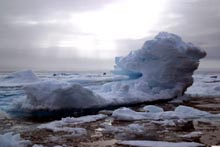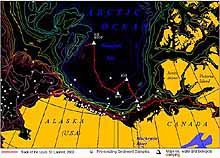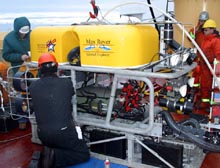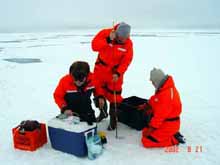
One of the many strange and beautiful ice formations spotted during the first half of the cruise. (Photo courtesy of Ian McDonald, Texas A & M.) Click image for larger view.

2002 Arctic Exploration cruise track from August 14th until August 24th. Click image for larger view.
Probes into the Unknown
August 24, 2002
Kathleen Crane
Mission Coordinator
NOAA Arctic Research Office
We are exploring what some scientists have called the graveyard of the Arctic. It is the 24th of August, 2002. The sun is shining brightly through my cabin window. Diving operations have commenced, and Wayne, Paul and Jeremy have donned their cold water wet suits and are preparing for another immersion under the ice, in search of any form of life in this seemingly lifeless world. Life in the Arctic Ocean is not always where you think it should be.
So little is known about this region of the Earth. We don’t even know the depths to the seafloor. We don’t know what types of animals and plants live under the ice, in the midwater or on the bottom. We have a very poor understanding of where or how fast the currents go, or how isolated they are from the rest of the Arctic and the world’s oceans.
Our expedition is like one from centuries ago. We have a ship filled with scientists to cover every discipline. There are biologists who are making a census of marine life, chemists to analyze the water masses, and physical oceanographers who are hoping to track the movements of the ice over several years.

Deep Sea Systems, Inc. technicians make final adjustments to the Global Explorer ROV in preparation for its first dive to the bottom of the Canada Basin, almost 3000 meters below the surface. (Photo courtesy of Ian McDonald, Texas A & M.) Click image for larger view.

Terry Whitledge, Rolf Gradinger, and Sang Lee of the University of Alaska Fairbanks prepare to collect samples in and under the pack ice. Their measurements will lead to a better understanding of primary productivity in the Canada Basin. (Photo courtesy of Quing Zhang.)Click image for larger view.
Sometimes, it is a daunting task to put all the programs together on one ship, but the results can be amazing. A few days ago, we lowered our new remotely operated vehicle (ROV), the Global Explorer, down to the bottom of the Eastern Canada Basin. What would be there? What creatures could inhabit this ultra-cold world, where water temperatures are normally –1.5 °C? Dives under the ice revealed no curtains of life, which, in some places in the arctic, have been found draping down from the ice above. The bottoms of the ice floes are an eerie blue and milky amalgam of cathedral-like spires, which hauntingly attracts our eyes. Terry Whitledge and Sang Lee have found formerly unknown microscopic layers of chlorophyll thriving, just under the blue tinted ice. It is a world where the light from the sun is diffused and embracing, rather than direct and focused. The hidden icy life of this ocean craves this iridescent light.
The divers say this is the clearest water they have ever seen, with visibility up to 400 feet. They can glance into the depths below. Before we lowered the ROV, we did not have any indication of where the life forms would congregate. Deeper and deeper we went. Finally, at around 1200-1500 meters, we entered a world full of life… No fish, but jellies, and amphipods…and more creatures we will decipher from the video. Yet strangely, there is no obvious physical or chemical signal at this depth. Why does life congregate here? It is a mystery that is waiting to be solved.
Once again, we entered a dark and empty world. The void continued until we approached the bottom, and there, to our amazement, swam thousands of small creatures—eelpouts with curlicue tails, gliding and swimming worms, crawling snails and burrowing clams. The clay on the seafloor is so pure that you could use it as a mudpack. It is covered on top by a myriad of small trails, remnants of life crawling over the surface. Geologists call these trails lebenspuren, a German phrase meaning "tracks of life." They are the pathways of the deep. How old are these tracks? The physical oceanographers suggest that water stays at the bottom of this basin for up to 100 years. If so, maybe these tracks we see are up to 100 years old as well. Geologists have suggested that vast and tall ridges have surrounded the Canada Basin for more than 100 million years. If so, then deep sea animals here may have been isolated from interaction with animals in any other parts of the world’s deep ocean. Do ancient forms of life still live here, preserved from extinction by the unique isolation from the world? Have novel forms of microbes, and macro-fauna evolved? We don’t yet know.
Sign up for the Ocean Explorer E-mail Update List.


























